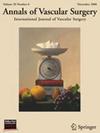一种新的小鼠浅静脉曲张模型:背襞入路
IF 1.4
4区 医学
Q3 PERIPHERAL VASCULAR DISEASE
引用次数: 0
摘要
虽然猪模型已经成功地建立了浅表静脉曲张的研究,但它们的广泛应用仍然受到大量成本和程序复杂性的限制。本研究旨在建立并系统表征一种新的小鼠浅静脉曲张模型,从而为未来的治疗研究提供有用的动物模型。方法采用在小鼠背部安装腔架的方法建立背褶腔模型。术后1周每天使用透射显微镜,测量观察窗内血管的长度和直径。采用组织学和免疫组织化学方法观察静脉的结构变化和病理变化。结果术后1周观察窗内静脉长度、直径变化明显。在组织学上,实验组的静脉观察到与人类浅表静脉曲张一致的表现,如管壁扩张、炎症增加、肠系膜萎缩和结缔组织变性。结论该模型形成的浅表静脉曲张在形态学和组织学上与人静脉曲张病一致。小鼠背褶模型被认为是评估浅静脉疾病病理生物学的一种合适的实验模型。它也可能适用于评估包括药物治疗在内的治疗干预措施。本文章由计算机程序翻译,如有差异,请以英文原文为准。
A Novel Mouse Model for Superficial Varicose Veins: The Dorsal Fold Approach
Background
While porcine models have been successfully established for superficial varicose veins research, their widespread application remains constrained by substantial costs and procedural complexities. This study aims to develop and systematically characterize a novel murine model of superficial venous varicosity, thereby providing a useful animal model for future therapeutic investigations.
Methods
The dorsal pleated chamber was modeled by installing a chamber frame on the back of the mice. Transillumination microscopy was used daily for 1 week postoperatively, and the length and diameter of the vessels in the viewing window were measured. Histology and immunohistochemistry were used to assess structural changes and pathological changes in the veins.
Results
One week after the procedure, the veins in the observation window showed significant length and diameter changes. Histologically, the experimental group of veins observed manifestations consistent with human superficial varicose veins, such as dilatation of the walls, increased inflammation, atrophy of the mesentery, and connective tissue degeneration.
Conclusion
Superficial varicose veins formed in this model have morphology and histology consistent with that observed in human varicose vein disease. The mouse dorsal fold model is considered a suitable experimental model for assessing the pathobiology of superficial venous disease. It may also be suitable for evaluating therapeutic interventions including drug therapy.
求助全文
通过发布文献求助,成功后即可免费获取论文全文。
去求助
来源期刊
CiteScore
3.00
自引率
13.30%
发文量
603
审稿时长
50 days
期刊介绍:
Annals of Vascular Surgery, published eight times a year, invites original manuscripts reporting clinical and experimental work in vascular surgery for peer review. Articles may be submitted for the following sections of the journal:
Clinical Research (reports of clinical series, new drug or medical device trials)
Basic Science Research (new investigations, experimental work)
Case Reports (reports on a limited series of patients)
General Reviews (scholarly review of the existing literature on a relevant topic)
Developments in Endovascular and Endoscopic Surgery
Selected Techniques (technical maneuvers)
Historical Notes (interesting vignettes from the early days of vascular surgery)
Editorials/Correspondence

 求助内容:
求助内容: 应助结果提醒方式:
应助结果提醒方式:


